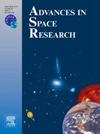Detecting surface subsidence trends in permafrost areas with undulating terrains using GPS interferometric reflectometry
IF 2.8
3区 地球科学
Q2 ASTRONOMY & ASTROPHYSICS
引用次数: 0
Abstract
Global navigation satellite system interferometric reflectometry (GNSS-IR) technology has been applied to detect surface deformation in permafrost areas. Affected by terrain, previous studies have mainly focused on GNSS sites located in permafrost areas with uniform flat surfaces; however, the number of sites is small, which limits the expansion of regional research. This study provides ideas for the detection of surface subsidence trends in permafrost areas with undulating terrains using global positioning system (GPS) interferometric reflectometry. We selected the GPS site AB33 in Coldfoot, Alaska, and the GPS signal-to-noise ratio (SNR) data during the 2023 snow-free thaw season were processed to obtain continuous surface reflector heights. Outlier detection of reflector heights to extract robust and reliable information and reflector height change trends were analyzed to identify satellite results of detected surface subsidence trends. Thereafter, hierarchical clustering was performed by azimuth and reflector height to group the satellite results into similar clusters and average them. Finally, the correlation between the surface subsidence trends detected at different azimuth ranges after clustering and the subsidence trends simulated by the thawing index was analyzed. The results showed that the detected surface subsidence trends strongly correlated with the simulated trends, with a maximum correlation coefficient (R) of 0.74. This verifies that the ideas presented in this study can effectively detect surface subsidence trends in permafrost areas with undulating terrains.
求助全文
约1分钟内获得全文
求助全文
来源期刊

Advances in Space Research
地学天文-地球科学综合
CiteScore
5.20
自引率
11.50%
发文量
800
审稿时长
5.8 months
期刊介绍:
The COSPAR publication Advances in Space Research (ASR) is an open journal covering all areas of space research including: space studies of the Earth''s surface, meteorology, climate, the Earth-Moon system, planets and small bodies of the solar system, upper atmospheres, ionospheres and magnetospheres of the Earth and planets including reference atmospheres, space plasmas in the solar system, astrophysics from space, materials sciences in space, fundamental physics in space, space debris, space weather, Earth observations of space phenomena, etc.
NB: Please note that manuscripts related to life sciences as related to space are no more accepted for submission to Advances in Space Research. Such manuscripts should now be submitted to the new COSPAR Journal Life Sciences in Space Research (LSSR).
All submissions are reviewed by two scientists in the field. COSPAR is an interdisciplinary scientific organization concerned with the progress of space research on an international scale. Operating under the rules of ICSU, COSPAR ignores political considerations and considers all questions solely from the scientific viewpoint.
 求助内容:
求助内容: 应助结果提醒方式:
应助结果提醒方式:


